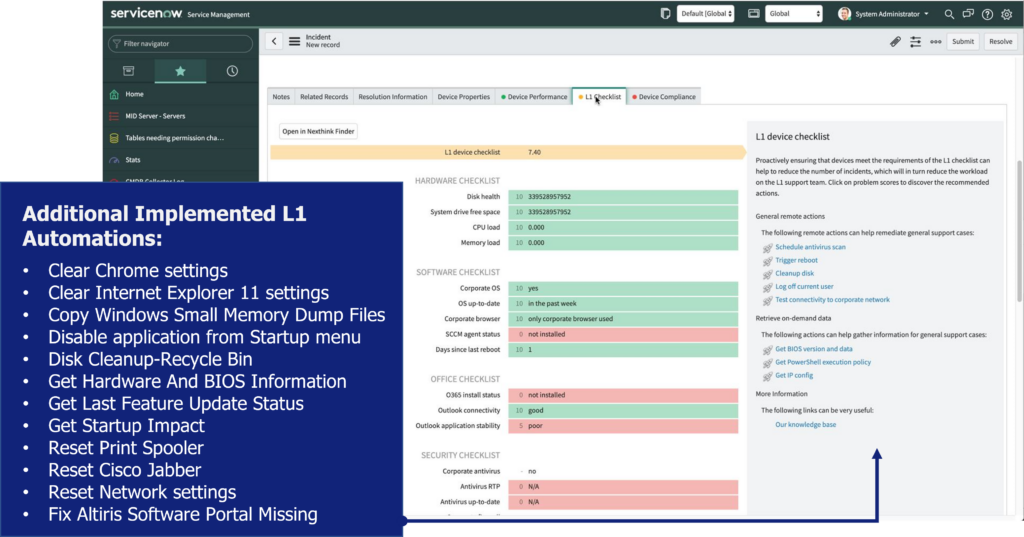1-Click Fixes in ServiceNow: $20k and 380 Service Desk Hours Saved
When faced with an overload of “simple” L1 tickets, this organization integrated smart automation enabling their L1 agents to stay efficient, save time and avoid rising costs. In just 3 months, the benefits were already evident.

Realized value in 3 months: 1530 executions, resulting in 383h and $20k saved
At the end of the day, incident management boils down to a vital KPI – Mean Time To Resolution (MTTR).
And the reason is simple: time is money.
This is why every Service Desk team is always trying to optimize their tools, processes and agility. Because a more efficient Service Desk can solve more issues at a lower cost.
Here is an example of how a leading high-tech company was able to enhance their service desk with a simple—yet powerful—integration to save time and money.
More Growth, More Problems
The organization was undergoing significant growth, but wasn’t investing proportionally in its Service Desk team. It was just a matter of time until the Service Desk was overrun with incoming tickets. This forced the Service Desk to rethink their processes to be more efficient using the same amount of human resources.
The company’s IT team had recently implemented Nexthink to help manage the organization’s new growth from a digital perspective. The Service Desk team took the opportunity to implement Nexthink’s ServiceNow integrations by integrating real-time data into their ServiceNow console—their main ITSM solution— and introducing self-help capabilities, as well as augmenting their CMDB intelligence.
But, in this example, I just want to focus on the simplest but—in their case—most effective integration – the L1 checklist with its automated single-click fixes.
From 15 Minutes to a Single Click Fix
When it came to ticket management, the L1 team was bearing the brunt of it – incessant small, common IT issues but that needed anywhere between 10 to 30 minutes to get in touch with the employee, retrieve device information and/or perform investigations; and, ultimately, implement the fix. Doing this device after device for every submitted ticket was not efficient, to say the least.
So they made a list of the 12 main L1 issues considered “simple, but requiring unnecessarily long time to resolution”. They then integrated additional Nexthink-powered automations (on top of those already available out-of-the-box), enabling L1 agents to automated the resolution of these issues in a single click, directly from their ServiceNow console. This was implemented for a 3-month testing period.
L1 teams could now avoid employee contact or long data retrieval processes by replacing them with automated remote actions. +-15 minute long incident management processes were now replaced by a single click.

Nexthink L1 checklist in ServiceNow with its list of suggested remote and automated actions on the right. (Blue box representing company’s additional automation for the testing period)
Calculating Success From Immediate Results
The 3-months testing period of this new feature was a total success.
The L1 team triggered 1530 automation executions in just 3 months from their ServiceNow portal.
1530 executions (previously solved at an average of 15-minutes) equates to 383 Service Desk agent hours saved
Using industry averages for salary and working hours and a back-of-the-envelope calculation reveals a conservative estimate of $20,000 savings* in that 3-month period.
1 new feature. 12 automations. 1530 executions. 383 hours avoided. $20k saved.
Not bad for a 3 month test period.
Next Steps
This implementation proved that the Service Desk didn’t necessarily need more agents – they just needed to be smarter and more efficient with the resources they already had.
The company is now building a longer list of automated actions to add to their Nexthink-enhanced ServiceNow L1 checklist. This will now become a core function of their L1 support with the objective to continue reducing MTTR and, ultimately, its related costs.
Demo: Finding Issues Quickly and Proactively with Nexthink+ServiceNow Incident Management Integrations
* Hours to cost conversation:
- (1530 executions x 15m/incident) ÷ 60 = 383 hours saved
- 383 ÷ (40h/week x 12 weeks) = 0.8 FTE (Full Time Equivalent) for 3 month
- 0.8 FTEs at ($25,000)= $20,000
Note: use of industry standards for confidentiality:
- Working time: 40h/week
- Service Desk Agent Cost to Business: $100,000
- 3 month equivalent: $100,000 ÷ 4 = $25,000
Related posts:
- The DEX Show | Podcast #7 – A Human Approach to the Future of Work w/ Paul Hardy
- How a company saved 32k hours of IT support and $1.6M on their Windows Migration
- Cleaning House – How One IT Team Saved $1.8M on SaaS Licensing
- How to Keep Your Digital Devices Current | Engagement & Automation